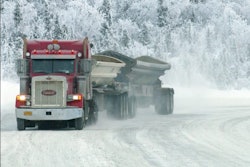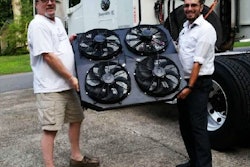 Got your own example of a do-it-yourself solution to a problem related to truck equipment or the owner-operator business? Send your story to [email protected] with the “highway hacks” subject line to be considered for the monthly feature.
Got your own example of a do-it-yourself solution to a problem related to truck equipment or the owner-operator business? Send your story to [email protected] with the “highway hacks” subject line to be considered for the monthly feature.Getting closer to the winter season, an inquiring mind among readers wanted to know:
I have had my convex mirrors crack in the wintertime more than once and was wondering if I am the only one and what people have found to stop it.
 Moisture between the housing and the mirror itself can be the cause when a mirror cracks in subfreezing temperatures.
Moisture between the housing and the mirror itself can be the cause when a mirror cracks in subfreezing temperatures.We put the question to owner-operator Mark Kirbyson, hauling in the frigid Northeast and Canada in a 2007 Peterbilt. For convex mirrors, provided they’re the familiar manual style, Kirbyson has dealt with cracks himself, particularly in winter.
He says moisture can get trapped between the back of the mirror and the housing. Not only can this rust fastening screws, but when the moisture freezes and expands, it also can crack the mirror. Kirbyson has tried preventive measures:
- Seal the housing. When installing replacement mirrors, add clear silicone around the fastening mechanism and around the edge of the housing to prevent entry of moisture.
- Manually create moisture drain. If there’s not one there that’s obvious, drill a very small hole in the bottom of the housing of a mirror already in place to allow moisture to escape when it does get behind the mirror.
At once, most manual convex mirror assemblies come with a drain hole, so improper mounting could be the issue, says Tennessee-based small-fleet owner-operator Wayne VanHooser. If there’s any question about how to mount the unit, be sure the hole is at the bottom, he says.










